Rating the most beautiful money in the world
One of the most unusual currencies we have encountered, perhaps, can be called the crown of the Faroe Islands, located in the North Atlantic between Scotland and Iceland. De jure islands belong to Denmark, but de facto it is a separate world with its own unique way of life. For example, residents of the Faroe Islands do not lock houses, there is simply no need, because there is practically no crime on the islands.
Issue 1. How did world currencies get their names?
Issue 2. Rating of the most beautiful money of the world
Issue 3. Composite coins - an alternative to paper and metal
Release 4. Money of the XX century: a selection of bills, out of circulation
Money on the Faroe Islands is also special and more like colorful postcards than national currency. Despite the fact that it is a Danish krone, it has a completely unique design. All bills are made in the style of watercolor on wet paper, and it is not just that. The fact is that on the Faroes it rains most of the year - up to 300 days a year. And the design of notes emphasizes this. Images of seashells, crab, fish and other monasteries of the ocean coast continue the maritime theme. Here are banknotes with denominations of 50, 200 and 500 CZK:
')
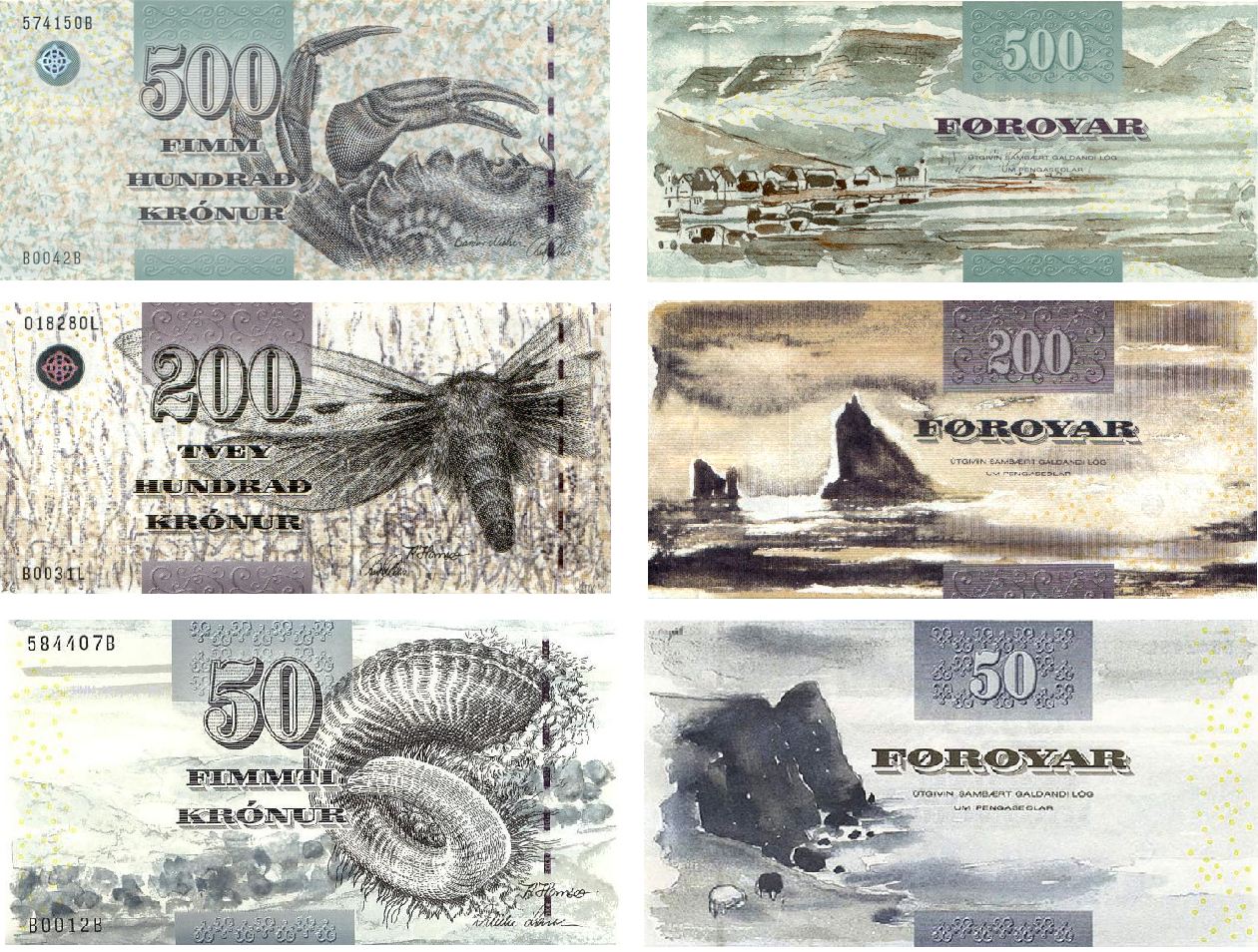
The reverse of the banknotes shows the sights of the islands - a guide to the most beautiful places. So, on the reverse side of the bill with a face value of 500 CZK you can see the panorama of the mountains near the town of Sørvágur. On “dvuhsotki” - the famous triangular rock near the village of Bøur:
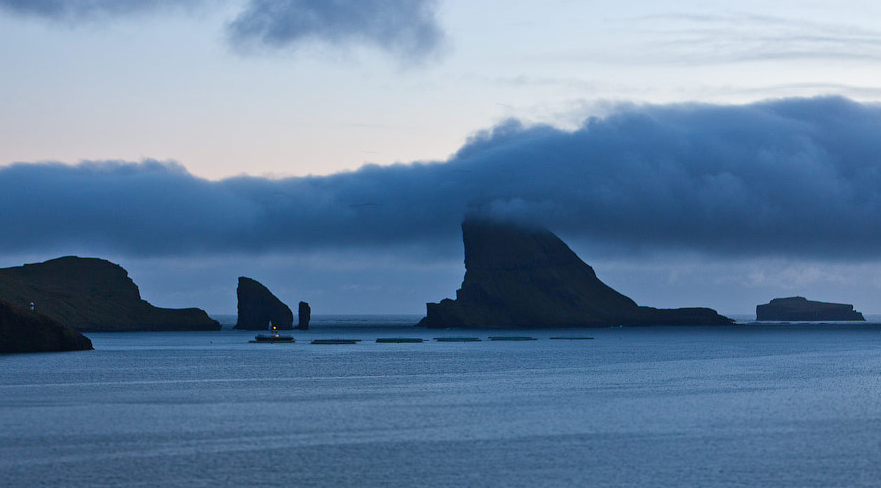
The issuer of banknotes - the National Bank of Denmark, it is he who owns the copyright on the design of bank notes.
The Faroese crowns are not inferior to the Rufian Republic of the Maldives. The island nation includes 1,300 islands and reefs, located 800 km from the coast of India. The Maldives is considered one of the poorest countries in the world, but the money they have is one of the most beautiful. The design resembles watercolor paintings, like the crown of the Faroe Islands, but the motive in the Maldives, of course, its own: coconut palms, fishing boats, locals, traditional household items, flora and fauna of the islands.
Another bright currency is the French Pacific Franc, like images from a travel book. The currency is used in the overseas possessions of France: on the territory of French Polynesia - an array of tiny islands located in the center of the South Pacific, as well as on the Island of Wallis and Futuna in the South Pacific and in New Caledonia. All banknotes depict locals, travelers, flora and fauna of the islands. For example, on the obverse of a bill of 500 French Pacific francs is a portrait of a fisherman and a fishing schooner. On the back side is a local resident on the background of a cliff and the sea shore.
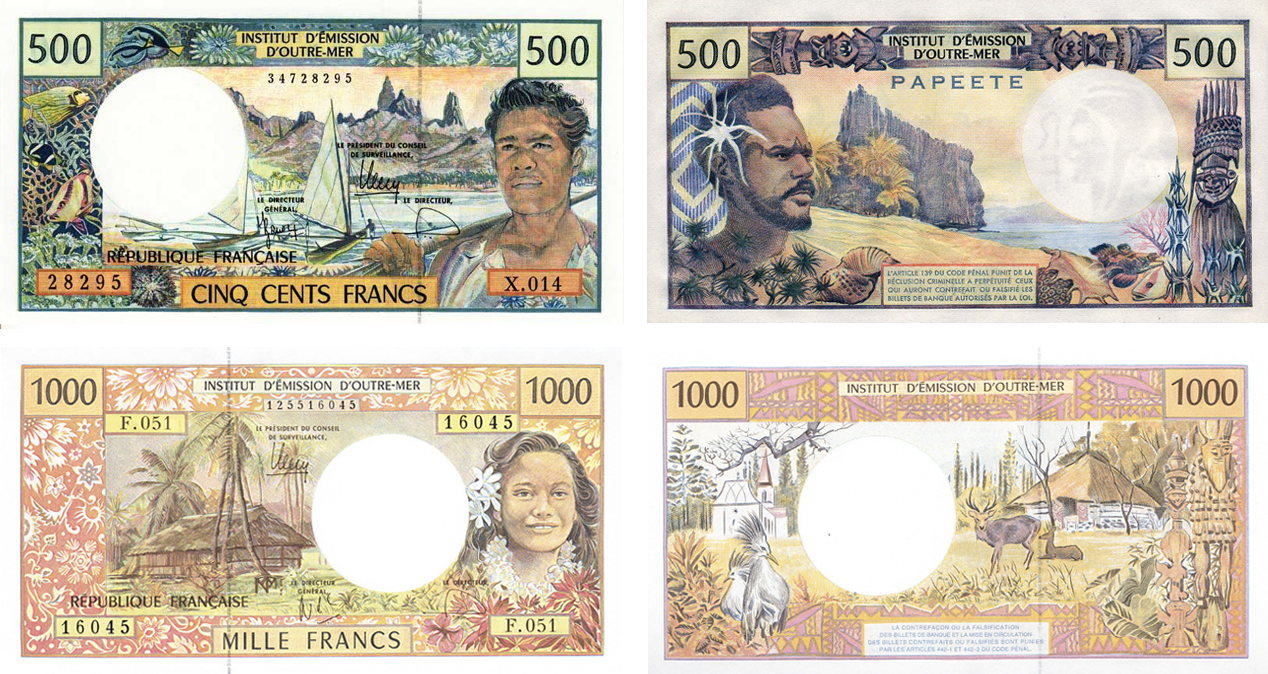
Strikingly, the Hong Kong dollar differs from tropical islands with sea motifs and local sights. The image placed on its bill is made in hi-tech style. As conceived by designers, such bizarre forms reflect the rhythm of life of modern people who are in constant motion, and the world around them is rapidly developing. In addition, such a futuristic appearance of banknotes significantly complicates the work of counterfeiters.

It is noteworthy that 4 organizations are immediately responsible for issuing Hong Kong currency - the Hong Kong government (coins and banknotes of 10 HK $) and three commercial banks: HSBC, Standard Chartered Bank and Bank of China. In addition, old money has not yet been withdrawn from circulation, but functions along with new ones. For this reason, local banknotes are very diverse, often surprising tourists.
And we have Europe next in line. As it turned out, here you can find examples of non-standard approach to the design of the national currency. Switzerland is one of the few European countries that did not want to switch to the euro, and recently recently withdrew the application for EU membership. The Swiss franc is one of the most stable currencies in the world. But not only this distinguishes it from other currencies. Swiss franc banknotes have a rather original appearance and non-standard horizontal arrangement of denominations and drawings. On the obverse of banknotes portraits of local artists are depicted. On the back - their most famous work. So, for example, a stylized portrait of a Swiss sculptor Alberto Giacometti and his famous sculpture “A man walking forward” is placed on a 100 francs banknote.

In denominations of other denominations are depicted: designer, architect Le Corbusier and fragments of blueprints of buildings built by him (10 francs), Arthur Onegger, poet, composer, and fragments of musical instruments (20 francs), Sofia Tauber-Arp, artist and sculptor, on the reverse - Dada's head (50 francs), Charles Ferdinan Ramus, prose writer, and fragments of his manuscripts (200 francs), Jacob Burckhardt, Swiss ethnographer, historian, and fragments of his works (1000 francs).
Another European country that uses its own currency is Sweden. Last year, the Bank of Sweden began to issue banknotes with new images, however, old-style cash tickets are still in use. One of them has a very unusual design. This is a bill in denominations of 20 Swedish crowns with the image of the portrait of the writer Selma Lagerlef on the obverse and the hero of her fairy tale Niels's Wonderful Journey with Wild Geese - Niels - on the reverse.

Now go to East Africa, to the Comoros - a small island nation in the Indian Ocean. For 130 years, until 1975, the Komory were a French colony. After independence, the state experienced political upheavals more than once. In contrast to the turbulent political life, on the banknotes of the Comorian francs, it is this monetary unit that bears the status of the national currency of the Comoros, and it depicts pacifying landscapes and local sights. But our attention was attracted not by the views of the islands, but by the color scheme in which the bills were made. The banknotes of 1000 and 5000 francs look especially picturesque:

The Samoan tala, the currency of the independent island state of Samoa, located in the South Pacific, looks no less colorful. On the obverse of a 5-tal denomination of a banknote there are huts and trees on the shore, on the reverse - the residence of the head of state. On the obverse of the 20 Samoan Talan banknotes is the Sopoaga waterfall, on the back is the toothed dove that inhabits the island.
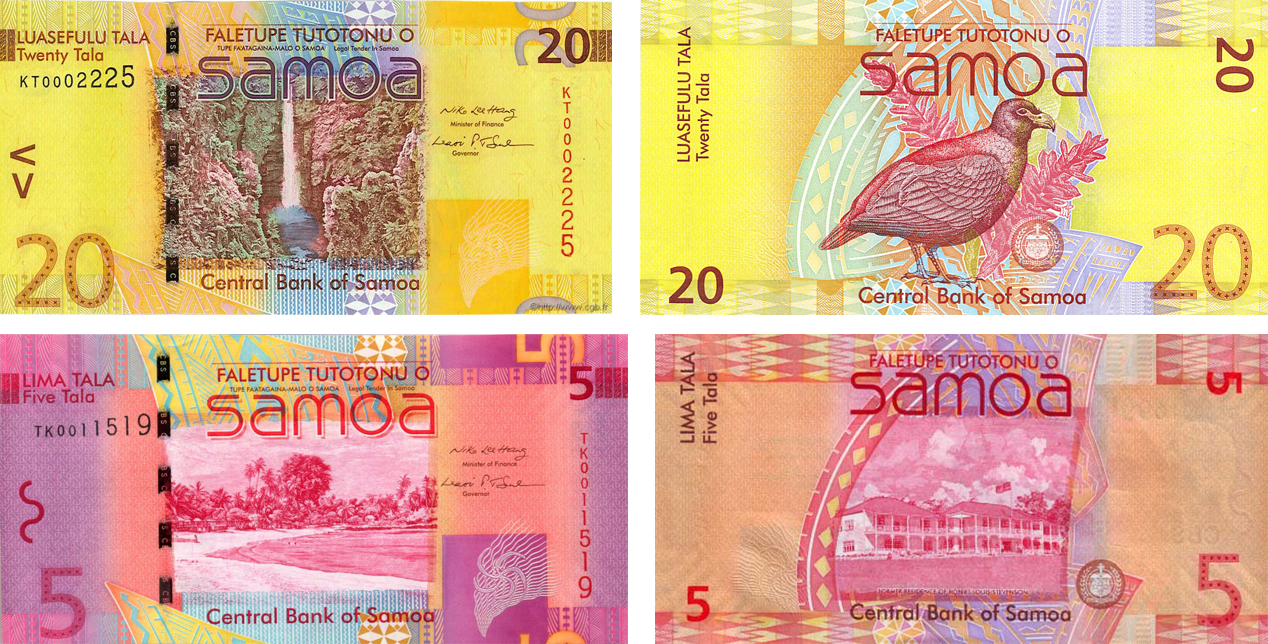
An interesting feature - unlike most states, Samoa retains the design of banknotes, each new series differs from the previous one only in the degree of protection against counterfeit.
And one more bright representative of world currencies - Fiji dollar. On the banknotes you can see the flora and fauna of the island nation, landscapes, attractions.
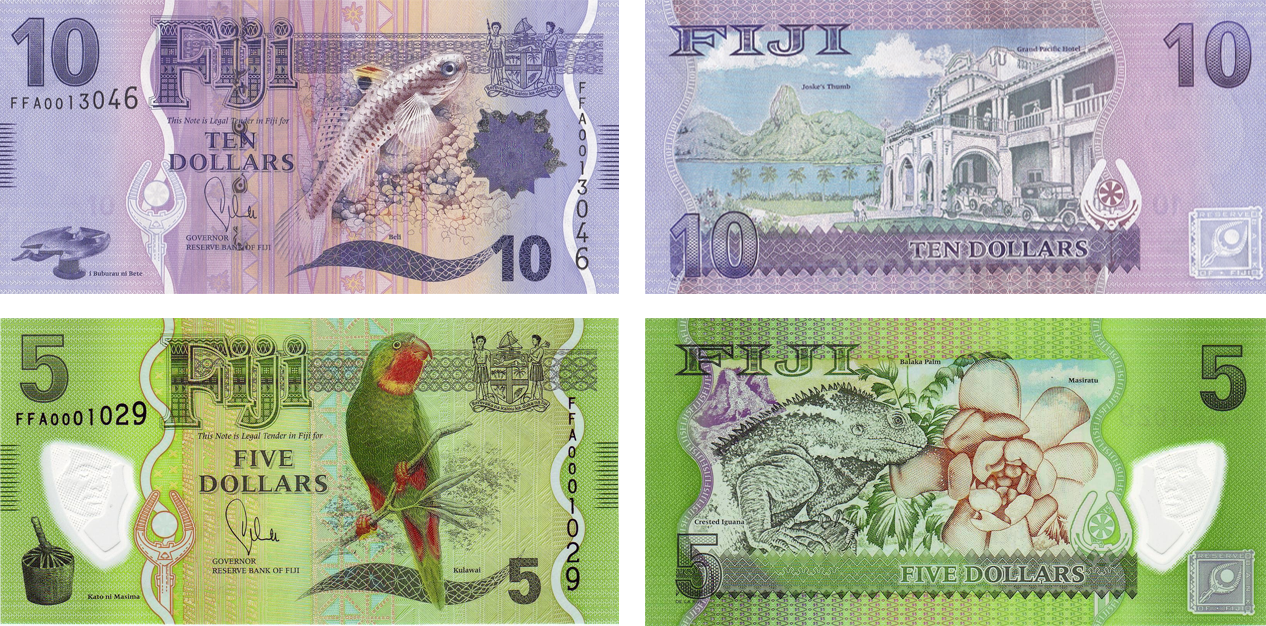
In continuation of the island theme, we present you the notes of Bermuda - Bermuda dollars:
Almost in the same color scheme are made banknotes of Papua New Guinea - kina. The 2 kina denomination denotes an ax of the tribes inhabiting the foothills of Mount Hagen, an armband for the tribes living on the shores of Milne Bay, engraved teeth of dogs from Bougainville Island, and a clay pot from the Sepik region. The 5 kin note contains an image of traditional Papua New Guinea money: a hombuli mask from the Sepik region, a kina (a necklace of seashells), a necklace of seashells from the province of New Ireland. The 10 kin banknote depicts bowls of tami, feathers of the bird of paradise, boar tusk from the central regions of New Guinea, tamba (money from shells from Eastern New Britain province). On the reverse side of bills - the building of the Parliament of Papua - New Guinea.
Another currency that has attracted our attention is Kazakhstan tenge.
In 2013, the 5000 tenge note from the “Kazakh Eli” series was recognized by the international banknote community “The Best Banknote of 2012”. The design of the denomination of 5,000 tenge was developed by the designers of the National Bank of the Republic of Kazakhstan. The front side shows the monument "Kazak Eli" - a symbol of independence of Kazakhstan, on the back side - an image of the outline of the map of the country, the top of the monument of independence and the building of the hotel "Kazakhstan" against the background of the Trans-Ili Alatau Mountains.

A year later, the tenge again became the winner in the nomination “The Best Banknote of the Year”. The award was given to “Memorable banknote with a nominal value of 1000 tenge, dedicated to the Turkic writing“ Kүltegіn ”.

This year the tenge was also marked. The banknote of denominations of 10,000 tenge topped the rating of the most beautiful currencies in the world according to the British edition of The Telegraph . On the front side of the 2003 sample bill is a portrait of the philosopher, thinker, scientist Al-Farabi. On the back is a snow leopard against a background of snow-capped mountains.

The Russian ruble, in our opinion, also deserves attention. In particular, the “Snowboarder” series of 100-ruble banknotes dedicated to the XXII Olympic Winter Games and the XI Paralympic Winter Games of 2014 in Sochi and a commemorative note of the 2015 Crimea and Sevastopol sample. The main images of the front side of the first bill are the figure of a snowboarder, the Olympic facilities of the coastal cluster in the city of Sochi. The main image of the back side is the Olympic stadium “Fisht” in the city of Sochi. The final circulation of these banknotes left 20.650 million copies.
The second note, the issue of which is dedicated to the annexation of the Crimea and Sevastopol to Russia, contains images of the hero-city of Sevastopol and the business card of the Crimea - the Swallow's Nest castle. The centerpiece of the composition on the "Sevastopol" side is the Monument to the Scuttled Ships. In the background is a fragment of the picture of I. K. Aivazovsky “Russian squadron in the Sevastopol raid”. Circulation of paper stubblevok dedicated to the Crimea, amounted to 20 million copies.
Quite an original design has a bill in denominations of 5 Bahamian dollars. The bill depicts dancing artists at the Junkanoo parade in Nassau. Down in the middle is the coat of arms of the Bahamas. The obverse of the banknote shows a portrait of Sir Cecil Wallace-Whitfield and a map of the Bahamas.
One more note of the Bahamas is interesting not so much by appearance, as by face value - a half dollar.
Further, Costa Rican columns with “animal motifs” settled in our ranking:
And the banknotes of the Republic of South Africa, DR Congo and Tanzania close the rating of beautiful currencies. The modern bills of the Republic of South Africa depict the “big five” animals of the African continent: an elephant, a rhinoceros, a buffalo, a lion and a leopard. The downside of banknotes is decorated with images of natural and industrial landscapes.
The theme of the “big five” can be traced on some other banknotes, such as, for example, on the bills of DR Congo, Congolese francs:
Or on Tanzanian shillings:
This concludes our rating. If you think that some currency was unfairly overlooked, write about it in the comments. If you have any questions about the operation of our service, or you want to connect payments on the website / mobile application, please contact us via the contact form or by phone.
All images are taken from open sources.
Source: https://habr.com/ru/post/395379/
All Articles